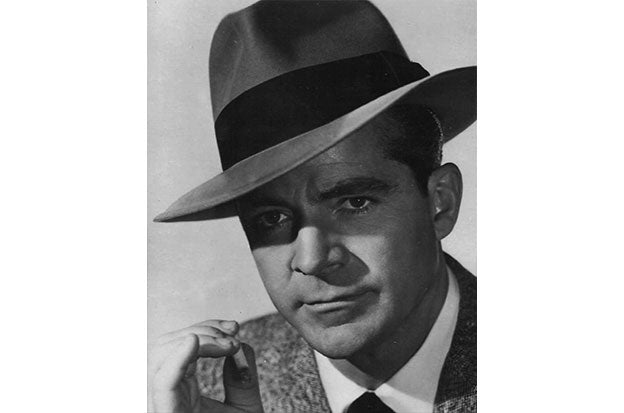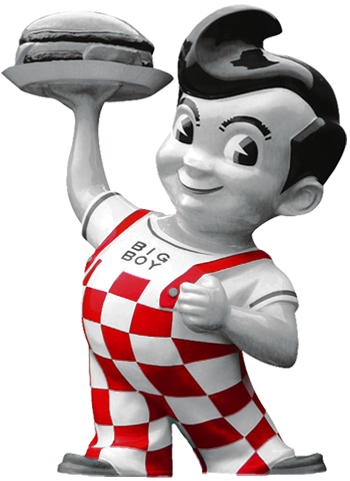Dana Andrews
 Dana Andrews in a press photo
Dana Andrews in a press photo
The farm boy from the South turned leading man, worked opposite all the great beauties, including Elizabeth Taylor, Susan Hayword, and most importantly Gene Tierney. Dana Andrews' most critically acclaimed work was with Tierney in Laura (1944).
Before he broke into show business, Dana started out pumping gas in Van Nuys. After some success, he raised his family in Toluca Lake for two decades at 4310 Arcola Lane. The Andrews went to Bob’s Big Boy Burbank to get the very best food and hospitality at a fair price.
 Dana Andrews and family
Dana Andrews and family
Every major studio and even The Pasadena Playhouse, turned down Dana Andrews at first. He applied again at the famed theater and drama company, and for reasons no longer clear, was accepted. The owners of the Van Nuys gas station paid for his studies in exchange for future earnings if he ever "made it." Dana would begin as a “spear carrier” in a Shakespeare production. Samuel Goldwyn eventually discovered him. Dana’s first “role” was on Raffles (1939). Goldwyn had him stand on set wearing the identical tuxedo costume as actor David Niven in an attempt to intimidate Niven into signing a new contract, which he quickly did.
 Anthony Quinn, Dana Andrews, and Francis Ford
Anthony Quinn, Dana Andrews, and Francis Ford
Dana Andrews makes his mark in Western "hanging" films. He leads a supporting cast in The Westerner (1940) with Gary Cooper and Walter Brennan. Often cited as one of his best roles, his small but impacful performance in The Ox-Bow Incident (1943) with Henry Fonda, gets Oscar-nominated for Best Picture. The film was added to the U.S. Film Registry in 1998.
 Gene Tierney and Dana Andrews
Gene Tierney and Dana Andrews
Laura (1944) is regarded as a masterpiece of cinema. Andrews, playing a New York City Police detective, falls in love with a painting of the woman whose murder he is investigating. The woman is played by Gene Tierney, one of the five films she would make with Andrews. In his first big feature, Otto Preminger, directs Dana Andrews as the solid center yet has him underplay his part, leaving space for the charismatic Clifton Webb and Vincent Price. The film ranks #4 on AFI's list of greatest American mystery movies of all time. According to The New Yorker the film is “Noir in a nutshell.” Roger Ebert includes it in his “Great Movies” series, stating “That Laura continues to weave a spell – and it does – is a tribute to style over sanity...” It won the Oscar for Best Cinematography and the title song “Laura,” has become a jazz standard recorded by virtually everyone, including Charlie Parker, Oscar Peterson, and Frank Sinatra.
Dana Andrews becomes known for his male mask — a masculine ideal of steel impassivity. He’s been suggested as the possible prototype for the “Don Draper” character, played by Jon Hamm in Mad Men. His eyes are alert, his suit is buttoned-up, he’s sharp but indifferent, suggesting an inner turmoil.
State Fair (1945) with Jeanne Crain was a Rodgers and Hammerstein musical hit. Unaware he was a trained opera singer; they dubbed Dana Andrews with Ben Gage. Thinking his colleague probably needed the work, Dana didn’t correct the oversight.
 Dana Andrews in the center
Dana Andrews in the center
The Best Years of Our Lives (1946) won seven (yes, seven!) Oscars, yet not even so much as a nomination for Dana Andrews. Today, however, he is often remembered and regarded the most for the definitive picture of a veteran adjusting to civilian life.
Boomerang (1947), directed by Elia Kazan, is based on a true story about a vagrant set up for murder, but prosecutor “Henry Harvey” played by Dana Andrews chooses to risk his career for the truth.
 Poster design by Saul Bass
Poster design by Saul Bass
Having worked with directors John Ford, Jean Renoir, Otto Preminger, William Wyler, and Elia Kazan, Dana Andrews would add Fritz Lang to the list. Andrews’ character hits a snag when trying to prove inadequate circumstantial evidence does not add up to Beyond a Reasonable Doubt (1956). And a serial killer is on the loose While The City Sleeps (1956). CineSavant, The AV Club, and Cineaste review both Fritz Lang film noirs starring Dana Andrews.
Dana Andrews delivers a strong performance as “Logan” in the excellent little Technicolor Western, Canyon Passage (1947), with Susan Hayword, Lloyd Bridges, and Hoagy Carmichael singing “Ole Buttermilk Sky.”
Ten years later he would work with the same director Jacques Tourneur for Night of the Demon (1957). The film about satanic cults, adapted from the M. R. James story "Casting the Runes" (1911), would earn him a lyric “Dana Andrews said prunes gave him the runes, and passing them used lots of skills…” in the Rocky Horror song "Science Fiction/Double Feature." The runes was a scroll, that when passed to a man, placed a demonic curse upon him.
 Sterling Hayden and Dana Andrews
Sterling Hayden and Dana Andrews
Dana Andrews falls into the not to be dismissed B-movie stage of his career with the “disaster” genre film, Zero Hour! (1957). Reuniting with actress Linda Darnell from Fallen Angel (1945), he plays the original “Ted Stryker” that saves the day by landing a passenger airplane whose pilots have fallen ill from eating the fish. The comedy Airplane! (1980) is literally a shot-for-shot remake, ironically starring Bob’s Big Boy Burbank Hall-of-Famer, Robert Hays as “Ted Striker.”
 Dana Andrews and Janette Scott
Dana Andrews and Janette Scott
The beautiful Brit bombshell, Janette Scott, also a lyric in a Rocky Horror song, plays Dana’s wife in A Crack in the World (1965). Unable to drill through the last layer of earth, a nuclear missile is fired in an attempt to get to the core. The film has a cult following.
 A teen rebellion film
A teen rebellion film
Over twenty years later in Hot Rods to Hell (1967), Dana Andrews reunites with State Fair (1945) co-star, Jeanne Crain. Once playing the love struck young couple, Dana and Jeanne are now parents with kids, being terrorized by a group of teenagers in a ’58 Chevy Corvette. The producers deemed the film too intense for television and released it theatrically, including drive-ins, instead. Wild teenagers, hot rods, and tons of car chases are the focus apart from the plot.
 William Holden and Dana Andrews
William Holden and Dana Andrews
Andrews was elected president of the Screen Actors Guild (1963-65). Following a meeting, William Holden, Dana Andrews, and former SAG-president Ronald Reagan, go across the street to continue their conversation at Gotham Restaurant. They all order drinks. The waiter returns 10 minutes later, Holden and Andrews both order another. And Reagan's just kind of looking at the two of them, puzzled, and says, "Why are you ordering another drink? You just had one." Dana sobered up in the 1970’s and enjoyed telling this story about the future of these three men, “Bill and I became alcoholics and Ronnie became President of the United States.” Dana’s real drinking issues began with Where the Sidewalk Ends (1950); however, it apparently did not render him incapable of working. Don Ameche, marveled at his professionalism, “Drunk or sober… he never misses a word.”
Andrews turned to real estate after becoming too old to be cast as a hero. After reading How I Turned $1,000 Into Five Million in Real Estate, Dana builds the Malabar Apartments, a 126-unit complex in Garden Grove, California. He said he made more money from real estate than he ever did in movies.
Carl Rollyson wrote the definitive biography on Dana Andrews, aptly titled Hollywood Enigma (2012). The book received favorable reviews from The Washington Post and The Wall Street Journal, who called Dana Andrews “The Forgotten Man.”
Despite his appearance in 70 films with the greatest directors and actresses of his day, in a style that paved the way for later steely actors, Dana Andrews has no star on The Hollywood Walk of Fame. Many believe his standing within the Hollywood pantheon should be reassessed.
Asked what film he enjoyed working on the most, he hesitated to name one, “I just love this business. That’s all.”
 Dana Andrews and Elizabeth Taylor
Dana Andrews and Elizabeth Taylor
